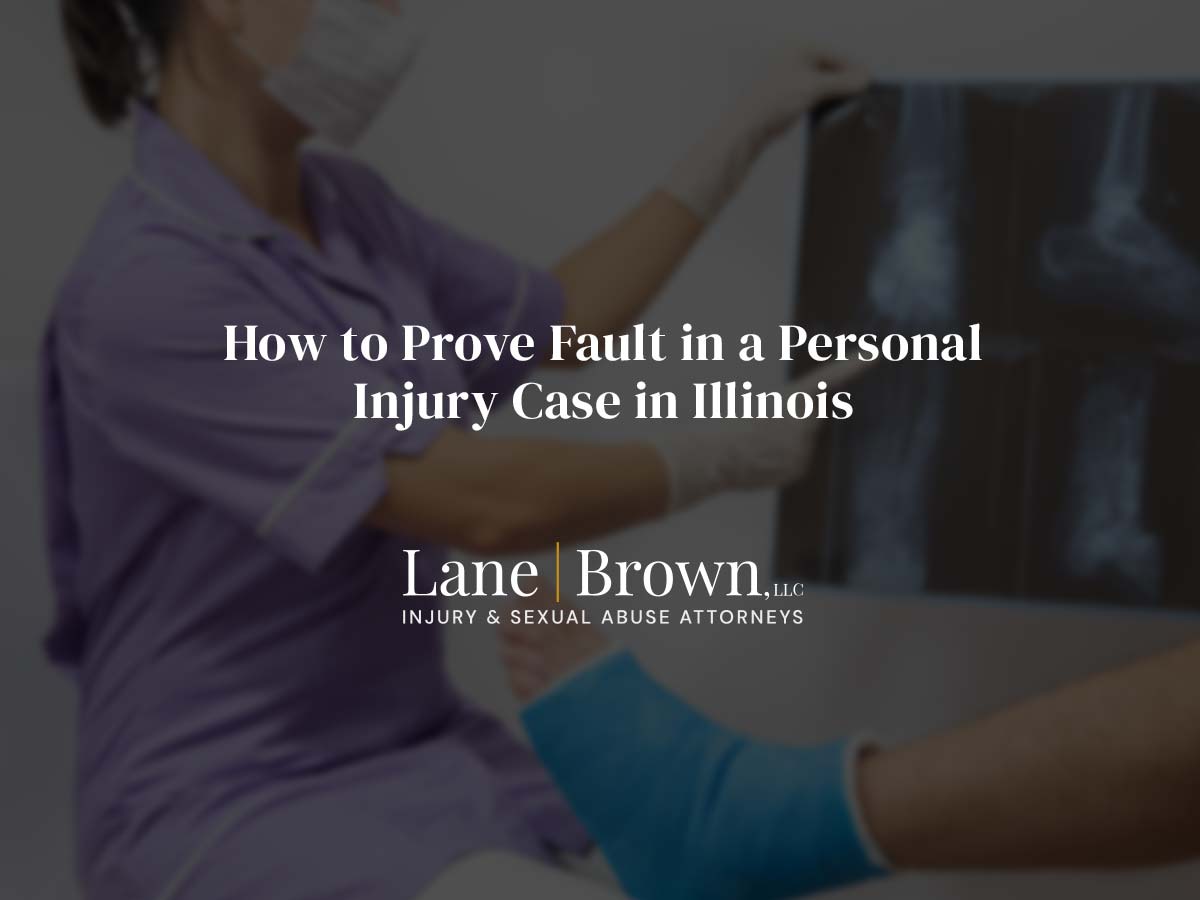Have you ever been in situations where you trip on a crack on the sidewalk or get rear-ended at an intersection? Although these incidents may appear insignificant, they have the power to create major disruptions in your day-to-day life. These occurrences often mark the commencement of a complex journey through personal injury law.
Inquiring about establishing fault in a personal injury case within Illinois? This undertaking is far from straightforward. It involves meticulous choreography, from comprehending the intricacies of negligence to the meticulous collection of concrete evidence.
Within this discourse, you will gain insights into the pivotal concepts of “duty of care” and “breach of duty,” which are the fundamental underpinnings of your claim. We will also help gather solid evidence like photos, witness statements, and medical records. These resources will prove without a doubt that it wasn’t my fault.
Decoding the Burden of Proof in Personal Injury Cases
The core aspect of personal injury cases in Illinois is establishing fault. The plaintiff needs to prove that the defendant’s negligence caused their injuries.
Negligence: What It Means and How It Works
Negligence is a failure to act with reasonable care under specific circumstances. If someone behaves differently than a prudent person, they may seem negligent. To prove negligence, you must consider four elements: duty of care (one person’s responsibility towards another), breach of duty (failure to fulfill this responsibility), causation (showing that the breach caused harm), and damages (proof of actual loss or harm).
Evidence Collection: A Vital Step
Gathering solid evidence is an essential part of supporting your claim. This can include photographs from accident scenes, medical reports detailing your injuries, witness testimonies backing up your version of events, etc. Hiring specialized expert witnesses for serious injury cases involving brain and spinal cord damage from accidents or fires can offer valuable insights for determining liability.
The Comparative Fault System in Illinois
Illinois follows a modified comparative fault system regarding personal injury claims. If you are partially responsible for an incident (up to 50%), you can still receive compensation. However, your own responsibility will reduce the amount you receive. Over 50% means no possibility of recovery. Always consult with an attorney before making any decisions; don’t replace legal advice with the content provided here.
Determining Fault: A Crucial Step
In personal injury lawsuits in Illinois, proving someone else was responsible for your injuries forms the crux of your claim. That usually means showing negligence—they didn’t act reasonably, given the circumstances leading up to the accident.
Evidence such as police reports from car accidents or fire department reports after fires and explosions is key to proving fault. Witness testimonies and expert evaluations give more weight to these facts by corroborating them.
Understanding the Elements of Negligence in Personal Injury Claims
In personal injury cases, proving fault is a complex process. Four key elements must be understood and proven to establish negligence: duty of care, breach of duty, causation, and damages resulting from the incident. In Illinois law, these four pillars are essential for a successful personal injury claim.
Four Pillars Are Essential for a Successful Personal Injury Claim
Duty of Care
Everyone is legally obligated to act responsibly towards others, known as the “duty of care.” For example, drivers must drive safely and avoid causing harm on the roads.
A Breach of Duty
A “breach” occurs when someone fails to fulfill their responsibility or acts unreasonably in specific circumstances. For instance, if a driver disregards traffic rules and causes an accident, it is evident they have breached their duty of care.
Causation
This element directly links your injuries to someone else’s negligence. It implies that you wouldn’t be suffering from the consequences if it weren’t for their reckless behavior or lack thereof.
Damages
To successfully conclude your case, you need substantial evidence demonstrating physical or financial losses resulting from someone’s failure to meet their obligations. Documents such as medical bills can be invaluable in supporting your claim.
These steps may seem simple, but they often require professional help. In serious cases such as wrongful death or brain/spinal cord injuries, seeking assistance from experienced firms like Lane Brown, LLC is important.
How to Prove Fault in a Personal Injury Case in Illinois

When you find yourself involved in a personal injury case in Illinois, it is essential to establish fault. However, proving negligence is not always a straightforward process.
Fault determination is of utmost importance in Illinois to ensure fair compensation. It is important to understand that Illinois follows a modified comparative negligence system. You can still receive compensation in Illinois even if you are partially responsible for the accident (up to 50%). The amount you receive will depend on the other party’s fault level.
1. Snapshots and Surveillance
Visual evidence from the scene of the incident can tell a compelling story. Snaps taken in the accident’s aftermath can give a vivid account of what happened. By leveraging nearby surveillance footage, our legal team can gain further insight into the sequence of events that occurred prior to the incident.
2. Eyewitness Accounts and Official Reports
Eyewitness statements can provide valuable insights into how the incident unfolded. If witnesses were present at the scene, their accounts could play a crucial role in establishing fault.
In addition, police or accident reports serve as formal records detailing every aspect of the incident. These reports are indispensable pieces of evidence when it comes to proving negligence.
3. Safety Protocols and Training Records
Examining the defendant’s safety and training history can uncover patterns of prior incidents like yours or education gaps that could have caused the accident.
4: Medical Documentation and Vehicle Data Recorder Information
We also rely on medical documents that show injuries caused by someone else’s carelessness. Additionally, vehicle data recorder information can help accurately recreate car accident scenarios.
5: Digital Traces: Employment Histories & Mobile Device Data
Employment histories can uncover any workplace-related trends relevant to your case. Furthermore, mobile device data can provide insights into potential distractions during the accident.
Key Takeaway:
Showing who’s to blame in an Illinois personal injury case isn’t easy. To establish a solid case, gather compelling visuals, thoroughly examine witness testimonies and official records, verify safety regulations and training logs, utilize medical records and car data recorders, and track digital trails such as job history and cell phone data.
Hire an Attorney
To make a strong case, hiring an experienced personal injury attorney is imperative. Legal representation is important for your case and necessary to create a solid and persuasive argument.
For instance, at Lane Brown, LLC, we have skilled personal injury attorneys with extensive knowledge of Illinois laws and regulations for proving fault. However, their expertise goes beyond that.
The Role of an Experienced Personal Injury Attorney
Our attorneys have a deep understanding of various types of injuries. Our team has a demonstrated record of accomplishment in managing such cases, from a brain injury caused by auto crashes to spinal cord harm brought about by fires. With this wealth of experience comes an acute attention to detail, which is invaluable when gathering evidence to establish liability in court.
Your Legal Compass: Lane Brown, LLC
If all this talk about legal intricacies has overwhelmed you, don’t fret. Our Lane Brown, LLC team focuses on handling cases involving wrongful death and serious injury due to brain and spinal cord damage. We specialize in issues caused by various factors, such as car accidents. We’ll guide you through every step, ensuring the best possible outcome for your case.
The Litigation Process If Settlement Negotiations Fail
Sometimes, settlement negotiations may not lead to satisfactory results. In such cases, litigation becomes necessary. To file a lawsuit, you need to go through the discovery phase. This is when both sides share information about witnesses and evidence for the trial.
Your legal team will begin filing a lawsuit by submitting documents explaining why the defendant should be held responsible for the harm or damage you experienced due to the accident or incident. The Discovery Phase: During this phase, both parties exchange information related to their claims and defenses, which helps better prepare for the trial.
Conclusion
Understanding the burden of proof is your first step in navigating a personal injury case in Illinois. The foundation rests on proving negligence, which involves elements like duty of care and breach of that duty.
Hiring a knowledgeable legal professional can also be your key to success; they’ll assist you in constructing an effective lawsuit and acquiring the greatest recompense. Filing your claim within two years preserves your rights under Illinois law is also imperative.
And finally, prepare for trial if necessary. Sometimes, it’s the only way to get fair compensation for damages incurred from a personal injury incident in Illinois.
Lane Brown, LLC, specializes in handling personal injury cases and serious injuries involving brain or spinal cord damage due to accidents or other unfortunate incidents. Let us help you seek justice after a serious injury or wrongful death. Reach out today.

